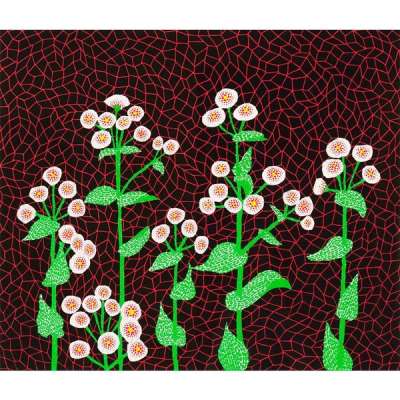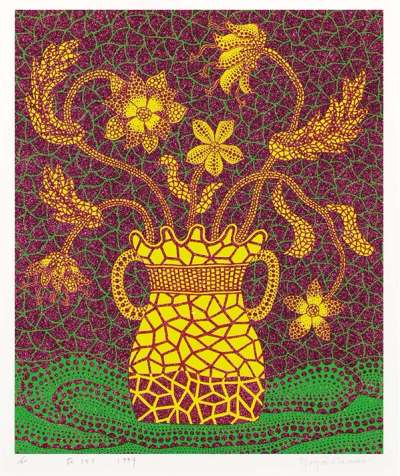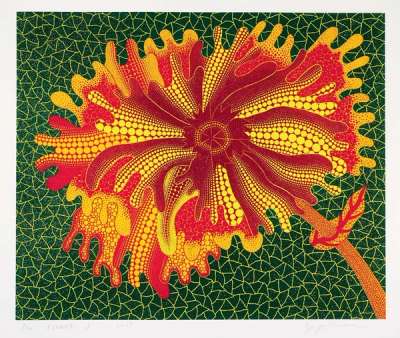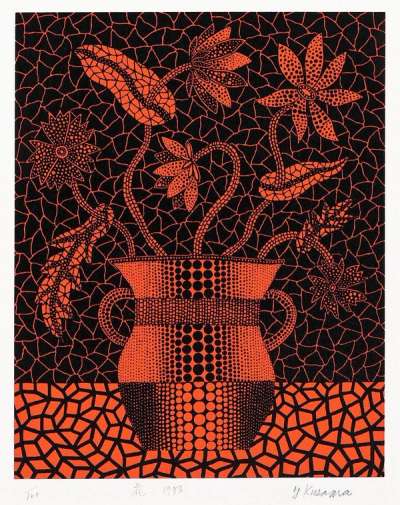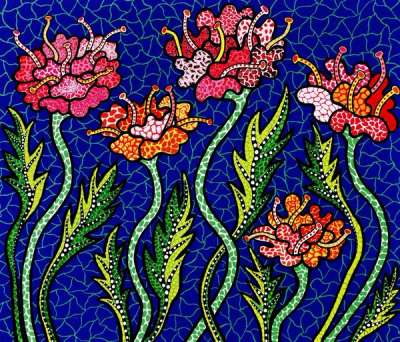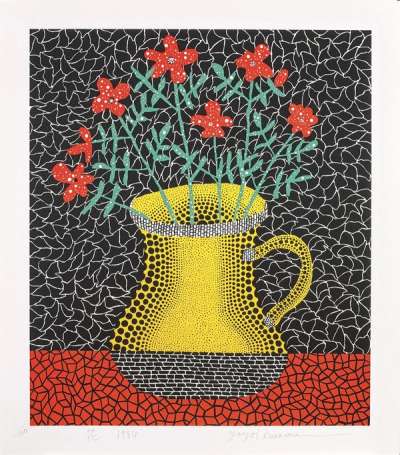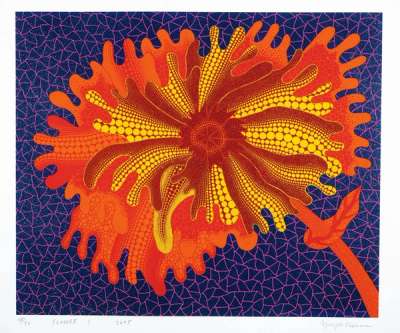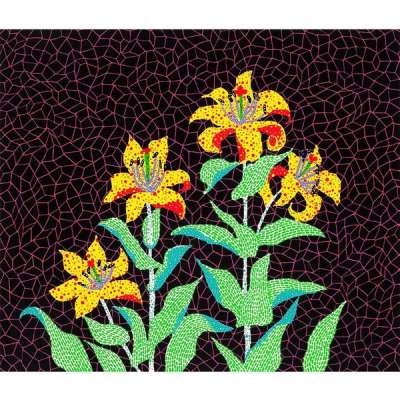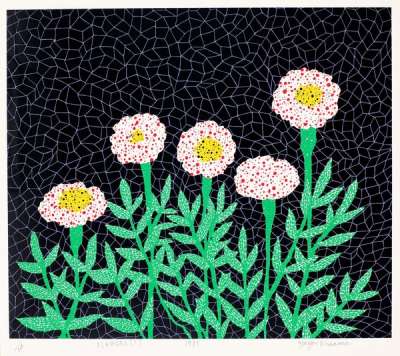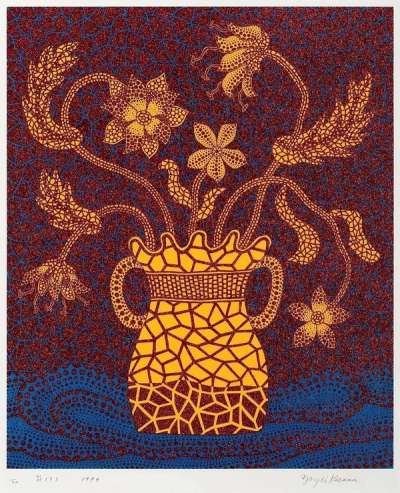Flowers
This unofficial collection of Yayoi Kusama’s gathers prints depicting flowers. Whether filling the page, pictured in a planted row, or gathered in a still-life of a bouquet, the flowers are celebratory in their colour, and playful simplicity, and depicted as ever in Kusama’s signature dots against net-patterned backdrops.
Yayoi Kusama Flowers For sale
Flowers Value (5 Years)
With £214505 in the past 12 months, Yayoi Kusama's Flowers series is one of the most actively traded in the market. Prices have varied significantly – from £474 to £37465 – driven by fluctuations in factors like condition, provenance, and market timing. Over the past 12 months, the average selling price was £12617, with an average annual growth rate of 16.88% across the series.
Flowers Market value
Auction Results
| Artwork | Auction Date | Auction House | Return to Seller | Hammer Price | Buyer Paid |
|---|---|---|---|---|---|
 Summer Flowers Yayoi Kusama Signed Print | 5 Sept 2025 | Mainichi Auction, Osaka | £12,325 | £14,500 | £17,000 |
 Flowers 1 Yayoi Kusama Signed Print | 5 Jul 2025 | iART | £7,225 | £8,500 | £9,500 |
 Flowers, Kusama 84 Yayoi Kusama Signed Print | 28 Jun 2025 | Neww Auction | £8,925 | £10,500 | £12,000 |
 Flowers 2 Yayoi Kusama Signed Print | 28 Jun 2025 | Neww Auction | £8,500 | £10,000 | £11,500 |
 Flowers FW Yayoi Kusama Signed Print | 26 Jun 2025 | Koller Zurich | £9,775 | £11,500 | £14,000 |
Night Flowers A Yayoi Kusama Signed Print | 26 Apr 2025 | Mainichi Auction, Osaka | £7,225 | £8,500 | £10,000 |
 Flowers B, Kusama 344 Yayoi Kusama Signed Print | 12 Apr 2025 | SBI Art Auction | £13,600 | £16,000 | £18,000 |
 Flowers 5 Yayoi Kusama Signed Print | 11 Apr 2025 | Mainichi Auction, Osaka | £10,200 | £12,000 | £14,000 |
Sell Your Art
with Us
with Us
Join Our Network of Collectors. Buy, Sell and Track Demand
Meaning & Analysis
Flowers dominate Japanese artist Yayoi Kusama’s art, often with an emphasis on their many alien-like forms and garish colours. This unofficial collection of Yayoi Kusama’s gathers prints depicting flowers: a mixture of mostly screen prints, and a few lithographic impressions.
Yayoi Kusama has a mixed relationship with flowers. They figured frequently in the artist’s childhood hallucinations, thus are an object possessed of uncanny terror. For example, she recounts, “‘I found myself trembling ... with fear, amid flowers incarnate, which had appeared all of a sudden. I was surrounded by several hundreds of violets ... chatting among themselves just like human beings.” Yet in keeping with Kusama’s undeterred fascination with all that has haunted her in hallucinations— patterns, dots, flowers— as subjects of wonder and mystical power, she chooses nevertheless to include them in her works.
Different species of flora have their own symbolic connotations, yet many of these are mixed: the same species might connote both life and death, or love and rejection. Kusama exaggerates this ambivalence by colouring her species however she chooses, representing all the varieties in a vase the same colour in Flowers 1-5, thereby obscuring their particularities and possible meanings. Overall, however, flowers are a particularly strong symbol of metamorphosis and seasonal change in Japan, home to the Sakura (cherry blossom) season after all, and thus reflect this dominant theme in Yayoi Kusama’s oeuvre.
In recent years, since the 2010s, Kusama has created several large scale, installation-based sculptures, such as Flowers that Bloom at Midnight and Flowers that Bloom Tomorrow and Flowers That Speak All About My Heart Given To The Sky. These sculptures, crafted in a mix of painted fibreglass and metal, loom above the viewer, weird and wonderful, with starkly unnaturalistic dotted petals and colours. Though they are fundamentally in the same vein as her flower on canvas or in print, in that they are a polished version of childishly drawn flora, they err on the more threatening side. In their large, somewhat monstrous, size, they seem to make more direct reference to the ‘obliterating’, overwhelming, flowers of Kusama’s hallucinations.
Whether filling the page, pictured in a planted row, or gathered in a still-life of a bouquet, Kusama’s flowers in print are more mundane than monstrous. They are celebratory rather than otherworldly in their vivid colour palette— dominated by the more naturalistic hues of red, green and yellow—and playful simplicity and are pictured against net-patterned backdrops, grounded and proportionate.

